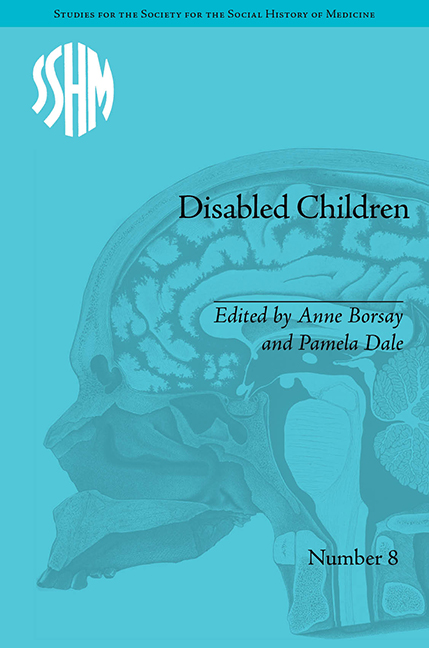Book contents
- Frontmatter
- Contents
- Acknowledgements
- Notes on Contributors
- Introduction: Disabled Children – Contested Caring
- 1 Club Feet and Charity: Children at the House of Charity, Soho, 1848–1914
- 2 Insanity, Family and Community in Late-Victorian Britain
- 3 The Mixed Economy of Welfare and the Care of Sick and Disabled Children in the South Wales Coalfield, c. 1850–1950
- 4 The Question of Oralism and the Experiences of Deaf Children, 1880–1914
- 5 Exploring Patient Experience in an Australian Institution for Children with Learning Disabilities, 1887–1933
- 6 From Representation to Experience: Disability in the British Advice Literature for Parents, 1890–1980
- 7 Treating Children with Non-Pulmonary Tuberculosis in Sweden: Apelviken, c. 1900–30
- 8 Health Visiting and Disability Issues in England before 1948
- 9 Spanish Health Services and Polio Epidemics in the Twentieth Century: The ‘Discovery’ of a New Group of Disabled People, 1920–70
- 10 Cured by Kindness? Child Guidance Services during the Second World War
- 11 Education, Training and Social Competence: Special Education in Glasgow since 1945
- 12 Hyperactivity and American History, 1957–Present: Challenges to and Opportunities for Understanding
- Notes
- Index
12 - Hyperactivity and American History, 1957–Present: Challenges to and Opportunities for Understanding
- Frontmatter
- Contents
- Acknowledgements
- Notes on Contributors
- Introduction: Disabled Children – Contested Caring
- 1 Club Feet and Charity: Children at the House of Charity, Soho, 1848–1914
- 2 Insanity, Family and Community in Late-Victorian Britain
- 3 The Mixed Economy of Welfare and the Care of Sick and Disabled Children in the South Wales Coalfield, c. 1850–1950
- 4 The Question of Oralism and the Experiences of Deaf Children, 1880–1914
- 5 Exploring Patient Experience in an Australian Institution for Children with Learning Disabilities, 1887–1933
- 6 From Representation to Experience: Disability in the British Advice Literature for Parents, 1890–1980
- 7 Treating Children with Non-Pulmonary Tuberculosis in Sweden: Apelviken, c. 1900–30
- 8 Health Visiting and Disability Issues in England before 1948
- 9 Spanish Health Services and Polio Epidemics in the Twentieth Century: The ‘Discovery’ of a New Group of Disabled People, 1920–70
- 10 Cured by Kindness? Child Guidance Services during the Second World War
- 11 Education, Training and Social Competence: Special Education in Glasgow since 1945
- 12 Hyperactivity and American History, 1957–Present: Challenges to and Opportunities for Understanding
- Notes
- Index
Summary
Introduction
In 2007 the Centers for Disease Control and Prevention (CDC) reported that 4.5 million American children, roughly 7 per cent of the school-age population, had been diagnosed with hyperactivity, or what is currently referred to as Attention-Deficit/Hyperactivity Disorder (ADHD). Characterized by impulsivity, inattention, over-activity, defiance and aggression, hyperactivity has been the most commonly diagnosed childhood psychiatric condition in the United States since the 1970s and stimulant drugs, such as Ritalin, have been used to treat the disorder since the 1960s. Hyperactivity has also been among the most controversial and most discussed disabilities to emerge after the Second World War. This is partly because of the powerful stimulants used to treat hyperactive children, and partly because of what the disorder implies about childhood, the education system and the way in which we perceive mental health. While many physicians have argued that hyperactivity is still underreported, critics have claimed that its existence is merely a myth constructed to curtail the natural development of children so that they conform to society's demands. Similarly, while some parents have resisted the diagnosis, believing that it labels their child unfairly, others see hyperactivity as a powerful heuristic, explaining a great deal about why their child has struggled to achieve educationally, socially and emotionally.
- Type
- Chapter
- Information
- Disabled ChildrenContested Caring, 1850–1979, pp. 173 - 182Publisher: Pickering & ChattoFirst published in: 2014



